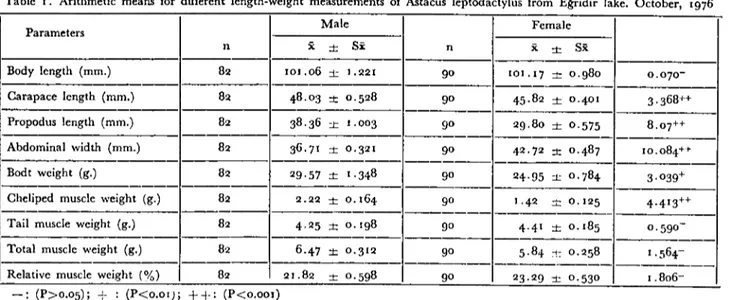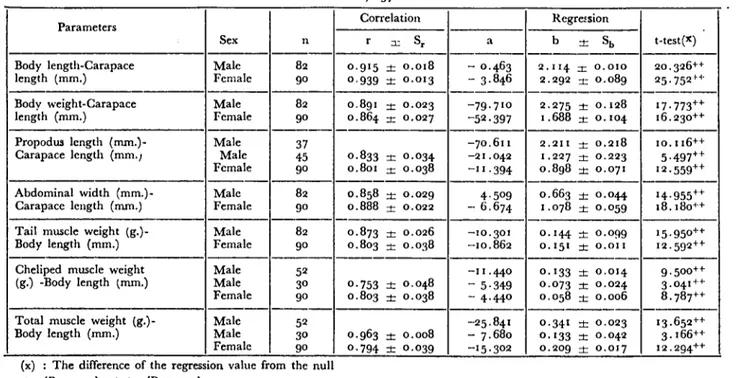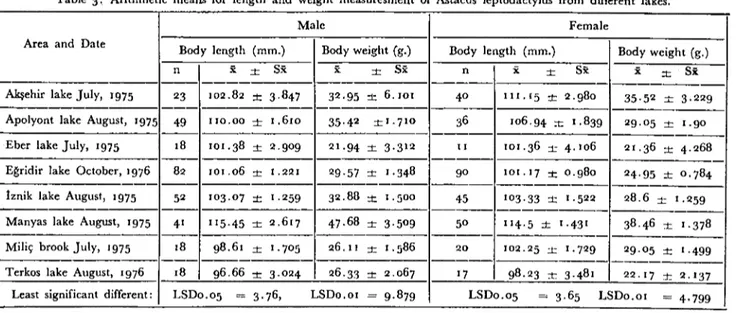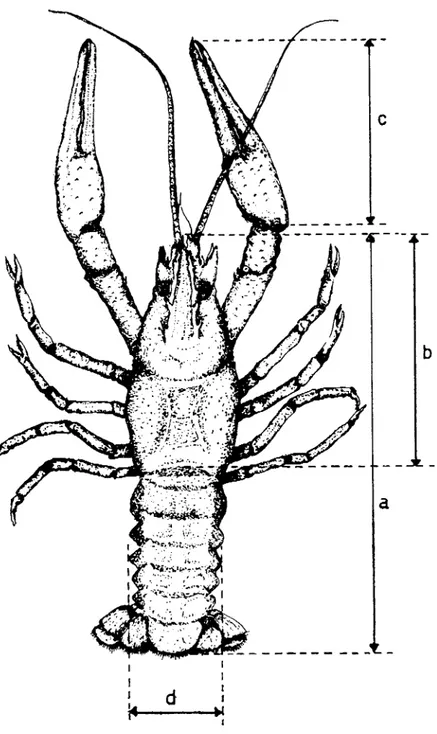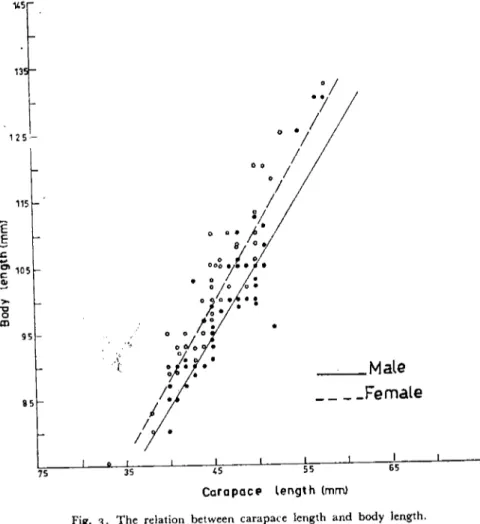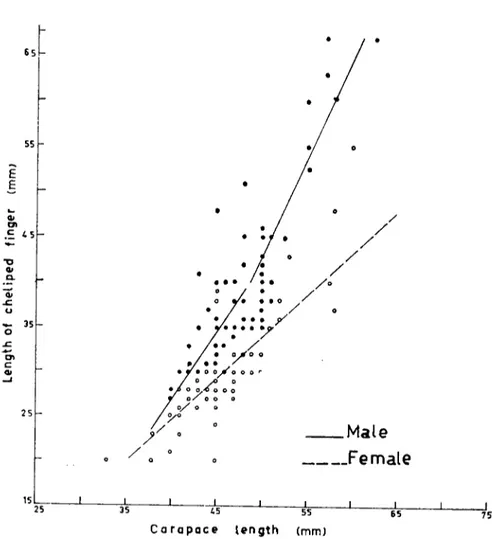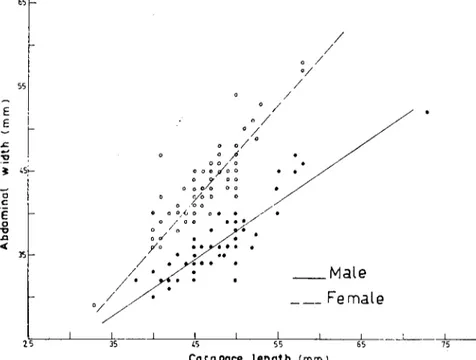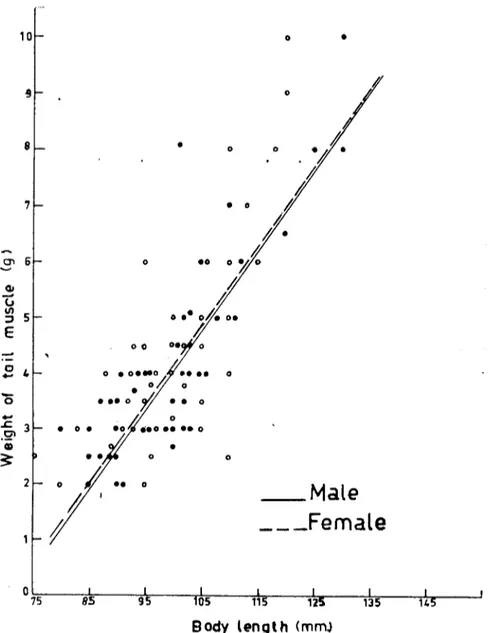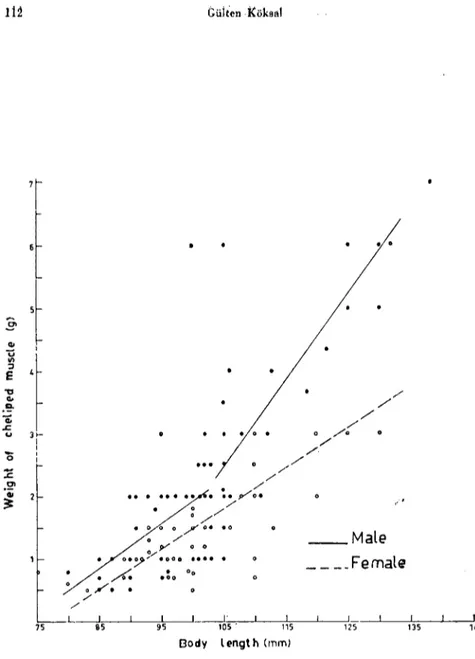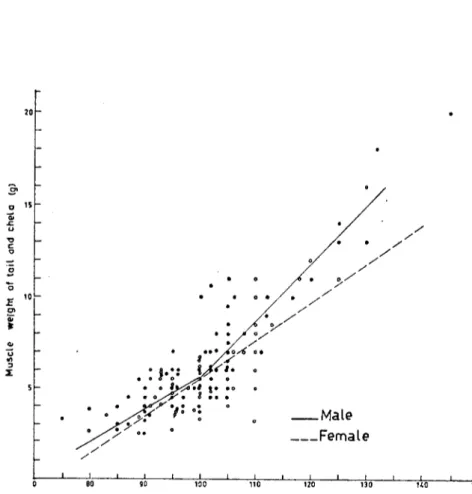A. D. Veteriner Fakültesi Su Drünleri, Balıkçılık ve Av Ha)":anları Kürsüsü Prof Dr. Zihrıi Erençin
BIOMETRIC ANALYSIS ON THE FRESHWATER
CRAYFISH (ASTACUS LEPTODACTYLUS ESCH. 1823)
WlDCH LS PRODUCED IN TURKEY - RELATIONSHIP
BETWEEN THE MAJOR BODY COMPONENTS AND
MEAT YIELD*
Gülten Köksal
* *
Summa ry: In this research the biometric anal.J'sis has been carried out on the major borIy components and meat yield rif crayfish (Astaclls leptodaclJlus Esch. ı823) which is an important fishery produet in Turkey.
A total rif753 crayfish (4:0gfemale, 344 male) were'collectedfrom the different lakes of Anatolia, where the (ra.J'fish populations were exploited.
Statistical relationships between the body components and meat J'ield f!f Astacus leptodaclJ'lus Esch. ı823 were represmted and compaı'ed with the other crayjish species and lobster.
Özet: Türkiye' de üretilen tatlı su istakozu (Astacus leptodaclJ'lus Esch. ı823) üzerinde ürün özelliği bakumııdan bfyometrik incelemeler.
Bu araştırmada, Türkiye'nin su ürünleri ekonomisinde önemli .J'eri olan tatlı su istakozunun (Astacus leptodaclJ'lus Esch. ı823) gövde ve verim (J'ene-bilen kısım, kas) özellikleri üzerinde bi.J'ometrik analizler yapılmıştır.
Istakodar başta Agridir gö'lü olmak üzere, çeşitli göllerden (Aporyont, Man)'as, hnik, Eber, A kşeh ir, Takos gölleri ve Miliç ça.J'ı) toplanmıştır.
*This study was suınmarized from the Ph. D. thesis and submilted lo the Faculty of
Veterinary, Ankara University, Turkey,
**Assistant Med. Vet. Department of ''''ater Producls, Fisheries and Wild Life, the
Giilicn Kiihnl
Dişi re erkek isirkodann gijIJde ile ıuim ö.celliklcrine ilişkin verilerle
bu ö::.ellikler cresındaki ilişkiler iste.fistiki oIr.rak incelenmiştir.
Elde edilen sOJwçlrmu, ista!w;darıı, beslenme, bü)'üme, erginlik durumları ile cv )!,:saklannıı ilişkin bo)' lIz1wlllğuil1m sı7,fJü:ıl'masındayararlı olabileceği
iizeriııde ic,rtışılmış le rJi.~erİstdo,: türleri ile karşda.rtırmelt'.1"lyalılmzştzr.
Intı-oductiCbn.
fresh'.\ialer erayfish is an important fishery produet in Turkey. Crayfjsh is in demand İn other European countries especially in Fran-cc, Swedcn, German)' and Italy.
According to rccent es(imates, the annual catch of the crayfish i\[;taclts lcptodactylus in Turkey is 1275 tom (1975). The minimum legal ~;izefor capture of crayfish is ıo cm. and trapping season is verl' lang (from July to (he beginning of (he ~Iay of next year).
Overfishing, long trapping season, pollution ete. have an advcrse effect on the crayfish growth, size and maturity. The total producti-on has dedined from year to year.
On the other hand, Ila information is available on the biology
and population dyncmics of this spccics in Turkey. Studies of crayfish biology frcqucntly require biometric analysis (9, iı). The statistical
analysis of the mcasurement is useful in determining relative condi-(ion, growth, size, sexual maturitl' and permit comparison of data from difrerent localitics (16). For thi$ rcasons, these circumstanees have prompt(~d us to rescrach into the biomctric anall'sis of Astacus lcptodactylu'; in Turkeyaimed at a coutribution to the present dec-line in production.
Mateı'ıials zllId Methods.
Most of the s,Lmples used in this study were trapped from the Eğ-riclir lake in Mal', Julyand OeıolJel' in 197G. Same of thcm were col-lccted from dif[erent Iakes such as Apolyünt, Manyas, İznik, Eber, Ak~ehir and the Miliç brook b(:t\\lccn in Julyand October in 1975.
A total of 753 crayfish wcre examincd in this study. Jmmedi8tely after remova! from the traps, the crayfishes \\"cre transported to the laboratory, weighcd and measurcd.
Four lengths wcre selected for the study: Body lcngth, carapace length, propodus length, abdominal width (Fig. ı).
After the measuring and weighing, the crayfish were İmmersed İn boiIing water for 5 minutes, then the muscle of taiI and chelae were carrefully removed and weighed. The pleopod eggs and the number of eggs İn ovaries were countcd.
Statistical analysis:
The cakulation of the values for the arİthmetİc means, standart deviations and standart estimates followed the procedures outlined by Kendir (12).
The regression of body length on the body weight was estİmated by the formula;
y= a+bx2
+
cx3 (7, 12).The significance of the differences between the mean values wcre tested (t-test) (12).
The analysis of variance were made to compare the differences between the lake groups and alsa sex groups İn respects of body we-İghts and body Iengths of the crayfish. The least significant differen-ces (LSDo'os LSDo'o1) were estimated for the lake groups (13).
J
252p J25SPLSDo'os=tO'2S -- LSDo'o1=tO'005
--no no
Phenotypic carrelatian coeffecients and regression equations between the traits were cakulated according to Snedecor and Coch-ran (I 7).
The condition factors of crayfish were cakulated from the
fol-100. W
lawing equation K= V which is given by Farmer (ıo).
Biometnc Anaıy~is On The Froshwater Crayfish ... 9S
Results and Dıscussıon:
The results of the deseri ptive analysis are summarized in the Tab-les and Figures.
The regression equations and associated statistics deseribing body length-body weight relationships of Astacus leptodactylus were rep-r~sented in the Table 1,2 and Fig. 2.
The males of Astacus leptodactylus were heavier than females (P<o.oı). This disparity between the sexes was due to the havier males chclipeds.
96 Gülten Köksn!
Correlation coefficicnts were apparent that, the two variables were positive and highly correlatcd for each sexes.
The mean body lengths for males and females did not differ sig-nificantly (P>0.05).
Many authors (ı, 2, 3, io, 14.) have provided body length-body
weight relationships for the different species of crayfish in different countries.
Abrahamsson (4) informed that the differences in thebody pro-portion of males and females of erayfish were renected in their body length-body weight relations. This weight disparity can be attribııtcd to the greater rat e of eheliped development in the males.
The similar findings were found in Finland by Lindqvist and Louekari (14). Thcy gave an excellent example of body length-body weight relationships for Astacus astacus. They also observed that the Iongererayfish were relatively heavier than females. The weight dif-ferenees between the sexes were due to the heavier male ehe1ipeds.
Some authors (6, IO, 14, 15) have obtained body
length-earapa-ce Iength (Cephalothrax Iength) and body weight-carapace length relationships.
Andersen (6) plotted carapace Iength against body Iength and obtained an arithmetic relationship with Nephrops norvegicus. But he did not caIculate the regression values for these estimates.
We obtained statistical reIationships between these variables for Astaeus leptodactylus. The mean carapace length for males and females were 48.03
+
0.528 mm., 45.82+
0.402 respectively. The values for males were high as compared with the females (P<o.ooı)(Table 1,2).
Statistieal analysis showed that a positive eorrelation occured between the body length and earapaee length. In both sexes when the carapaee length has increased the body Iength has increased too (Fig. 3).
The regression eoeffieients of body length-carapace length for both sexes were not significantly different (P>O.05). But on the cont-rary the regression coefficient of body weight-carapace length equ-ation were significantly different (P<o.oı). The inercas of body we-ight especiaIly in the larger size males were higher than females as depending on the carapaee length (Fig. 4).
Bİometnc Analysİs On The Freshwater Cray£i~h.••
Some investigators (IO, i4) have presented carapace
length-pro-podus length (cheIiped finger) relationship for different species. They have found that the propodus Icngth of male crayfish were higher than the females. Our results showed similar findings with Astacus lepto-dactylus (Fig. 5).
Lindqvist and Louekari (14) have given a detailed description about the width of the third (widest) abdominal segment of Astacus astacus. They have found that the width of the third abdominal seg-ment was 20.7
-+
0.28 mm. (n=83) in males and 24.5-+
0.23 mm. (n=98) in females. The abdomen was 18%
wider in the females than the males (P<o.ooı).Farmer (ıo) informed that there were distinct differences between the abdominal width of the males and females of Nephrops norvegi-cus. The difference between both sexes refIects the increased width of the abdomcn in females for carrying eggs (4, IO, 14).
In our study, available data on the relationship between abdo-minal width and carapace length are given in Table 1,2., Fig. 6.
The mean abdominal width (third) was 42.72
-+
0.487 mm. for females. The abdomen was 16%
wider in the females than in the males. Thesc estimated values were higher than the values of Asta-cus.We have recorded also a positive corrcIation between the cara-pace length and the abdominal width for both sexes. The increasing rate was always higher for females than males.
The great part of edible meat (muscle) of crayfish was obtained from the taH.
Some authors (8, 14, 18) have investigated reIationships between body components and meat yield.
Lindqvist and Louekari (I 4) informed that the weight of the tail muscle has about the same both sexes for Astacus astacus. But the we-ight of the chelipcd muscles were higher in the males than in the fe-males.
'Ve havc rccorded similar results with Astacııs leptodactylus (Fig. 7). We have estimated also a positive correIation between the cheliped muscles and body lengths in both sexes the body length has increased whiIc the cheliped muscles has increased. The inereasing rate was relativcly higher formales than females (Table I, 2., Fig. 8).
Giilten Kök~Il)
Generally the minimum legal size for captııre of cra)fish is 100 mm. in the lakes of Turkey. Therefore in our study, comparisons were made between the samples with 100 mm. or the longer body length and the others. Males, longer than 100 mm., relativeIy had more che-liped muscIes than females. These differences were significant (P< 0.001) Fig. 8). For this reason from the standpoint of meat producti-on, the present minimum legal size 100 mm for catching crayfish in our lakes seems justified as far as the males are concemed; the meat production in males increases sharply above this size. But here we observed the fact that the longer females also produce more eggs.
According to Lindqvist and Louekari (14-), in Astacus astacus females the production of total meat is indipendent of body weight, whereas larger males produee relativeIy more meat, this difference is nearIy all duc to the relatively larger cheIiped size in the males. They have also caleulated the mean relative musck weight for all the males was 18.1
+
0.27%
and for all the females was 17.1+
0.18%.
In our study, the total muscIe weight of the males and females was found almost the same for Astacus leptodactylus. But the total muscIe weight of the males larger than 100 mm. had heavier muscle weight than the females. This differcnce was due to the inercasing cheliped muscle, but it was not statisticaly significant (P>0.05) (Tab-le I, 2., Fig. 9)' The mean relative muscIe weight was 23.29
+
0.53°%
for the females and 2i.83+
0.598%
for the males. These valueswere higher than values of Astacus astacus.
Stewart et al. (18) inform that changes in total muscIe weight were not confined to disproportinate changes in any one of the major body components. According to them, the relative muscle weight of lobsters (Homorus americanus) was between 19.9
%
and 23%
of their body weight The another study about the proportion of the meat in an introdueed specie, Orconectes limosus Raf., in Poland by Dabrowski et al.(8) informed that the average meat yield of the clas-ses of 7.LO cm. was 24.07%
for the females and 24.30%
for the males.According to them if the crayfish wcight inercases, the percantage of the meat yield also inercases.
Estimates of the fecundity of diffcrent species of crayfish such as Astacus astacus L., Pasifastacus leniusculus Dana, Orconectes li-mosusRaf., and Nephrops norvegicus L. have been carricd out by so mc authors (I, 2, 4, 5, ıo, 14, 19).
Abrahammson (4) was obtained a positive eorrdation hetween body length and numher of pleopod eggs in hoth Astacus and Paci-fastacus. We ohserved similar results wİth Astacus leptodactylus (Fig.
ıo).
Biomelrıc Analysis On The Frcshwalcr Crayfisb ... 99
According to Lindqvist and Louekari (14), the mean numher of ovarian eggs was 248
-+
68 (n=68), and the regression equation was y=6.41 X - 363.8. In our study, the mean number of pleopod eggs was 183.06-+
9.047, the mean ovarian egg numher was 210.08-+
7.24 (P<0.02). Here we must consider the fact that this differenee is due to the length of ineuhation period and not all eggs attach to the pleopods during egg-Iaying (4, ıo).In our study, when the state of nutrition (condition faetor) of crayfish was investigated in the lake Eğridir, it was found that the males generally showed a better state of nutrition than the females. There was alsa a distinct change in the state of nutrition throughout the year, the change is higher in hoth males and females in the autum than in spring. A similar situation ",as found in the lohster, N. nor-vegicus (ıo).
In our study the variance analysis made on the samples, taken from different lakes has shown significant differenees between the sexes for the body length (P<o.oı). But there was no difference het-ween the sexes in the same lake. There were significant differences in respcd of hody weight between the both sexes and this difference have changed from lake to lake tTable 3)' The reason of the weight differences between the crayfish out the different lakes was not dear, therefore overfishing, pollution, irrigation may be cantributory fac-tors. We do not know the influenee of temperature, food supply, po-pulation densityon populatian stability.
Abrahamsson (5) informed that the Astacus population in Ri-ver Alcan was unexploited and therefore contained high populatian of large individuals.
Same authors (I, 2, 3, 4, 5, 14-,J9) indieated that the
tempera-r",ture, food supply and populatian density were the most important environmental factors and these influenees the growth rate.
Imxeasing importanee of the freshwater crayfish (Astaeus lepto-daetylus Eseh. 1823) in respeets of the fishing industry and 1he possi-bilities of exports have indueed us to this study.
Table i. Arithmetic mearıs for different length-weight measurements of Astacus leptodactylus from Eğridir lake. üctober, 1976
Male Female
Parameters
n ii. :t: Si< n ii. :t: Sx
Body lcngth (mm.) 82 101.06 :i: 1.221 9° 101.17 ..,..
-
0.g800.070-Carapace length (mm.) 82 48.03 :t: 0.528 90 45.82 :t: 0.4°~ 3.368++
Propodus length (mm.) 82 38.36 :1: 1.0°3 9° 29.80 :t: 0.575 8.07++
Abdominal width (mm.) 82 36.71 :t: 0.321 9° 42.72 :t: 0.487 10.084++
Boot weight (g.) 82 29.57 :t: 1.348 90 24.95 :i: 0.784 3.039+
Cheliped muscle weight (g.) 82 2.22 :t: 0.164 go 1.42 :t: 0.125 4.413++
---
---Tail muscle weight (g.) 82 4.25 :t: 0.lg8 9° 4.41 :t: 0.185
0.590-Total muscle weight (g.) 82 6.47 :t: 0.312 go 5.8,.j.:-'!: 0.258 1.56Ç
---Relative muscle weight (Ol,,) 82 21.82 -+- 0.598 90 23.29 :t: 0.530
Table 2. Regressian values and eorrelation eoeffieienls betwccn the different parameters of Astaeus leptodaetylus from Eğridir lake. Oetober, 1976
Correlation Regrc.<sion
Parameters
Sex n r :ı: Sr a b :t: Sb t-test(lt)
Body length-Carapaee Male 82 0.915 :t: 0.018 - 0.463 2.114 :ı: 0.010 20.326++
length (mm.) Female 90 0.939 :t: 0.013 - 3.846 2.292 :t:0.089 25.752++
---Body weight-Carapaee Male 82 0.891 :t: 0.023 -79.710 2.275 :t: 0.128 17.773++
length (mm.) Female 90 0.864 :ı: 0.027 -52.397 1.688 :t:0.104 16.230++
PropodWl length (mm.)- Male 37 -70.611 2.211 :t: 0.218 10.116++
Carapaee lengÜı (mm.) Male 45 0.833 :ı: 0.034 -21.042 1.227 :t: 0.223 5.497++
Female 90 0.801 :ı: 0.038 -Iı. 394 0.898 :t: 0.071 12.559++
Abdominal width (mm.)- Male 82 0.858 :t:0.029 4.509 0.663 :t: 0.044 14.955++
Carapaee length (mm.) Female go 0.888 :t:0.022 - 6.674 1.078 :t: 0.059 18.180++
Tail muscle weight (g.)- Male 82 0.873 :t: 0.026 -10.301 0.144 :t: 0.099 15.950++
Body length (mm.) Female 90 0.803 :t:0.038 -10.862 0.151 :t: 0.011 12.592++
---Cheliped muscle weight Male 52 -11.440 0.133 :t: 0.014 9.500++
(g.) -Body length (mm.) Male 30 0.753 :t: 0.048 - 5.349 0.073 :t: 0.024 3.041++
Female 90 0.803 :t: 0.038 - 4.440 0.058 :ı: 0.006 8.787++
Total muscle weight (g.)- Male 52 -25.841 0.341 :ı: 0.023 13.652++
Body length (mm.) Male 30 0.963 :t: 0.008 - 7.680 0.133 :t: 0.042 3.166++
Female 90 0.794 :t: 0.039 -15.302 0.209 :t: 0.017 12.294++
(x) : The differenee of the regression value from the nuH
+: (P<0.002):
+
+: (P<o.ooı)>-=
e.~.
•..
o•..
Table 3. Arithmetic means for length and weight measuresment of Astacus leptodactylus from different lakes.
Male Female
Area and Date
Body length (mm.) Body weight (g.) Body length (mm.) Body weight (g.)
n i :l: Si i :l: Sx n x :l: Si< i :t: Si
Akşehir lake July, 1975 23 102.82 :t: 3.847 32.95 :l: 6.101 4° 111.15 :t: 2.980 35.52 :t: 3.229
Apolyont lake August, 1975 49 110.00 :l: 1.610 35.42 :t:1.71O 36 106.94 :c 1.839 29.°5 :t: 1.9°
Eber lake July, 1975 18 101.38 :t: 2.9°9 21.94 :t: 3.312 ii 101.36 :l:4.106 21.36 :l: 4.268
---Eğridir lake October, 1976 82 101.06 :t: 1.221 29.57 :t: 1.348 9° 101.17 :l: 0.980 24.95 :l: 0.784
İznik lake August, 1975 52 103.°7 :t: 1.259 32.88 :t: 1.5°0 45 103.33 :l: 1.522 28.6 :l: 1.259
Manyas lake August, 1975 41 115.45 :t: 2.617 47.68 :t: 3.5°9 5° 114.5 :l: 1.431 38.46 :t: 1.378
Miliç brook July, 1975 18 98.61 :l: 1.7°5 26.11 :t: 1.586 20 102.25 :J: 1.729 29.°5 :t: 1.499
---Terkos lake August, 1976 18 96.66 :t: 3.024 26.33 :t: 2.067 17 98.23 :tc 3.481 22.17 j: 2.137
Biomelrıc Analysis On The Fre5hwater Crayfish ...
References
103
1- Abrahaınsson, S. (I966): Dynamics rif an isolated populetion
qf the crayfish Astacus astams Linne. OIKOS. if (I): 96-1°7.
2- Abrahaınsson, S. and R. C. Goldınan (197°): Distribution,
density and production qf the crayfish Pecifastacus leniusculus Dana in
Lake Tahoe, Califorızia-Nevada. OIKOS. 2i (I): 83-9 i.
3- Abrahaınsson, S. (197i): Population ecology and relatioıı to envi-ronmental factors rif Astacus astacus Linne and Pacifastacus leniusculus
Dana. Disscrtation, Department of anima! eco!ogy University
of Lund. i i.
4- A,brahaınsson, S. (I 97i): Density, growth and reproduction in
po-pulation of Astacus astacus and Pacifastacus leniusculus in an isolated
pond. OIKOS. 22 (3): 373-380.
5- Abrahaınsson, S. (I972): Fecundity and growth rif some population
rif Astacus astacus Linne in Sweden. Instituc of frcshwater research,
Drottningholm Report, 52: 24-37.
6- Andersen, F. S. (1962): The Norway Lohster in Faeroe Waters.
Medd. Dan. Fisk. Havunders., (Ny ser) 3 (9): 265-326. 7- Arkin, H. and R. R. Colton (I956): Ekonomi, işletmecilik,
psiko-loji, eğitim ve biyoloiiye uygulanan istatistik metodlar. Ayyıldız Matbaası
A. Ş., Ankara, 1968, 68-72. (Çeviren: H. Saim Kendir). 8- Dabrowski, T. et al. (1966): Studies on chemical compositian rif
Ame-rican crayfish (Orconectes limosus) meat as related to its Ilutritive value.
J.
Fish. Res. Board Can. 23 (II): 1654-1662.9- Erençin, Z. (ı97S): Tatlı su istakozu-Kerevides üretimi-bunun
Tür-kiye ekonomisindeki önemi üzerinde rapor. Fırat Ü. Yet. Fak. Derg.
2 (2): 2°4-2°9.
10- Farıner, A. S. D. (1975): SY'lOpis of Biological Data aLLthe }ı/orway
Lobster. FAO Fis . Synop., i12 :97.
i i - Geldiay, R. ve A. Kocataş \i97°): Tiirki.J1edeAstacus (Decapoda)
populasyonlarının dal,ılıs ıe taksonomik tesbiti. Ege Ü. Fen Fak. İln-i
Raporlar Serisi. No. 94.
12- Kendir, H. S. (ı977): İsatistik kurs notları. A.Ü. Yet. Fak. Ankara.
i3- Li,
J.
C. R. (I96i): Introduction to statistical injerence. Ed"vars104 Gültcn Köksnl
14- Lindqvist, O. and K. Louekari (1975): Muscle and
hepato-pancreas werght in Astacus astacus. L. (Crustacea: Astacidae) ir,
trap-ping season in Pinland. Ann. Zool. Fennici. 12:237-243.
15- Moriarty, C. (1973): "A study of Austropotomabius pallipes in
Tre-land" 58-67, Abrahamsson, S. (1972). Preshwater crayfish.
Prin-ted in Swcden StudentIittcratur.
16- Romaire, P. R. et al. (1976): Length-weight relationslıips of two
commercially important cra)!fishes of the Genus Procambarus. Papers
from the Third International Symposium on Freshwatcr
Cray-fish Kuopio, Finland, 1976. .
17- Snedeeor, W. G. and W. G. Coehran (1967): Statistical
met-hods. The Iowa Statc University Press, Ames 10wa, U.S.A.
135-17°, 176-198, 50-65.
18- Stewart,
J.
et al. (I 967): Muscle weiglıt relationship to serumpro-teins, hemocytes and hepatopancrees in lobster, Homarus americanus.
J.
Fish. Res. Board Can. 20 (I i): 2339-2354.19- Svardson, G. (1949): Stunted cra:f.fislı population in Sweden. Insti-tute of freshwater research, Drottnirıghoim Report, 29: i35-145.
Biornctne Analysis On The Freshwater Crayfish ...
c
a
b
105 i i J 14d
i i i i"ı
iFig. I. Certain size parameters in crayfish a) total length; b) carapace length; c) propodus
106 Gülten Köksal
90
80
The body length-body weight relation in the present crayfish sample from Eğridir
lake. 165 155 11.5 tLS
__
Male
____ Female
125 115 E30dy L engt h (mm) ° 105 95 85/
oL i i i / / o / J, /0/
la / /0 / / / g;o • 0/00 • .°1 o •• 9"0 •• oO/0 °~o<ıg ••00 ~ o 00 oo..,.,
•• o 0/ o~yo 009" / .,,-?' " o • 1>' /' 70 65r 60 55 50 ol 451
•....• 40~•..
..c olı
w i ~ 35 - >-"o " CD 30 25 20 15 10 5 75 Fig.2.Biometne Anıılysis On The Fre~lıwater Crayfish ... 107 145 75 i 65 55 45 35
.:
/
1
o 01
1
o oi
o / /i
~i
bO o o. /~ 8/ o o o ,. o 000lo
o o o •oıo o.
oJ. o. ••
• o o o o o ~: • .•.• o~ • .L:;tl: .
o oM ale
i:
i
-- -
_Female
/ / 85 75 95 -'15 13. i
125.-Carapaep length (mm)108 70 Gülten Köksal 60
•
50 o o cl 40 o1:
cl Gl ~ >- 30 1:7 Oro
20__
Male
/
___ Female
10 o 30 40 i 50 Car(]pace 1 L 60 length (mm) i 70 i BO .JBiomelrıc Aualysis On The Freslıwatcr Crayfiah ... 109 o o o
__
Male
____ Female
o•
•
•
•
/ / / / / /0 /.
. ...
.
/ ~-:
..
/'..
/ •• : ~O o • eo%oo" o ~ o 07°-6ooo o o o o 0/o yo ,l/ o /•
6J
~i E"i
Er
•..
Gl m c 45 "o Gl ı:ı. a; .c u-
35 o .c.-
D'I C Gl ~ 25 15 25 i 35 45i Carapace length i ss (mm) i 65 i 75110 Gülten Köksal __ Male ___ Female i 75 i 65 o o i i 45 55
Cara paı:t' length (mm) i. 35 / / o / 0/ / / o / 0/ 0/ 0/ o o o
.t:'
ooo~ooCl:~ ::
o cl ,~o cl o cl Cl..(ı cl Cl.. / • cl ,'. o o ••• / o /(i • • 0'/ • • • ya ••• •. • /.:
.
....
/ o /0 / 0/~51
i r ii
E 551 E i .c.r
'"' 'Q ~ ••S~ i o i cJ
.e
o ~ .o '" ~ 25Biometne Analysis On The Freshwater Crayfish ..• ııı 10 o
•
8 7 (]ı 6 o o o o. o•
o .0 ••• 0 /. •••• • o // o • •• orj' ••
o.ad ••
0.: ..
o
__
Male
___ Female
o o o o••
• o. 2E
4 o 75 8S Bady length (mm.)112 Güiten KökBal
T
,t
2',~
ciL f-ü i ii)t
:ı E ""cı. .'="a:
J:. u 3>-ı i 'ö i i ~ ol "ii ~ 75 i 95 i' 105 . i 115 __ Male ____ Female i 125 i 135,
HS Body length (ınm)Fig. 8. The relation between body Iength and cheIiped muscle weight \propodite,
ıd
Biometnc Analysi9 On The Frcshwater Crayfish ... 113
E-D 15 o; £. u ."C o 2 'o 1: 10 cı
••
•..
ü '""
:ı: o i.:: • o':;;A'.I •• o r. B ~:Y .,: .:>.
o .> / / /' /' / /' / ./ / / ~./ / ./ / /" Y 0/ o /' 01""6 OL ./ f"lo ıo o o • _Male ___ Female BO i gO 100i i 110 i 120 ı llO i,.0
i 150 Bady length (mm)Fig. 9 T. he relation betwccn body length and total mU5clc weight (ınuscle wcight of tai!
1I4 Gülten Köksal soo •
